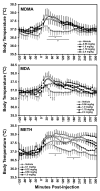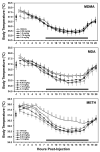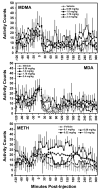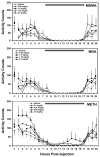Effects of (+/-)3,4-methylenedioxymethamphetamine, (+/-)3,4-methylenedioxyamphetamine and methamphetamine on temperature and activity in rhesus macaques
- PMID: 16876329
- PMCID: PMC1853374
- DOI: 10.1016/j.neuroscience.2006.06.033
Effects of (+/-)3,4-methylenedioxymethamphetamine, (+/-)3,4-methylenedioxyamphetamine and methamphetamine on temperature and activity in rhesus macaques
Abstract
Severe and malignant hyperthermia is a frequently reported factor in emergency department (ED) visits and fatalities in which use of amphetamine drugs, such as (+/-)3,4-methylenedioxymethamphetamine (MDMA), (+/-)3,4-methylenedioxyamphetamine (MDA) and (+)methamphetamine (METH), is confirmed. Individuals who use "ecstasy" are also often exposed, intentionally or otherwise, to several of these structurally-related compounds alone or in combination. In animal studies the degree of (subcritical) hyperthermia is often related to the severity of amphetamine-induced neurotoxicity, suggesting health risks to the human user even when emergency medical services are not invoked. A clear distinction of thermoregulatory risks posed by different amphetamines is therefore critical to understand factors that may produce medical emergency related to hyperthermia. The objective of this study was therefore to determine the relative thermoregulatory disruption produced by recreational doses of MDMA, MDA and METH in nonhuman primates. Body temperature and spontaneous home cage activity were monitored continuously in six male rhesus monkeys via radiotelemetric devices. The subjects were challenged intramuscularly with 0.56-2.4 mg/kg MDMA, 0.56-2.4 mg/kg MDA and 0.1-1.0 mg/kg METH. All three amphetamines significantly elevated temperature; however the time course of effects differed. The acute effect of METH lasted hours longer than MDA or MDMA and a disruption of nighttime circadian cooling was observed as long as 18 h after 1.0 mg/kg METH and 1.78-2.4 mg/kg MDA, but not after MDMA. Activity levels were only reliably increased by 0.32 mg/kg METH. It is concluded that while all three substituted amphetamines produce hyperthermia in rhesus monkeys, the effects do not depend on elevated locomotor activity and exhibit differences between compounds. The results highlight physiological risks posed both by recreational use of the amphetamines and by current trials for clinical MDMA use.
Figures




Similar articles
-
Oral administration of (+/-)3,4-methylenedioxymethamphetamine and (+)methamphetamine alters temperature and activity in rhesus macaques.Pharmacol Biochem Behav. 2007 May;87(1):11-9. doi: 10.1016/j.pbb.2007.03.015. Epub 2007 Apr 3. Pharmacol Biochem Behav. 2007. PMID: 17475314 Free PMC article.
-
Hyperthermia induced by 3,4-methylenedioxymethamphetamine in unrestrained rhesus monkeys.Drug Alcohol Depend. 2006 May 20;82(3):276-81. doi: 10.1016/j.drugalcdep.2005.09.013. Epub 2005 Nov 11. Drug Alcohol Depend. 2006. PMID: 16289931 Free PMC article.
-
Caffeine promotes hyperthermia and serotonergic loss following co-administration of the substituted amphetamines, MDMA ("Ecstasy") and MDA ("Love").Neuropharmacology. 2006 Jan;50(1):69-80. doi: 10.1016/j.neuropharm.2005.08.006. Epub 2005 Sep 26. Neuropharmacology. 2006. PMID: 16188283
-
MDMA, methamphetamine and their combination: possible lessons for party drug users from recent preclinical research.Drug Alcohol Rev. 2007 Jan;26(1):9-15. doi: 10.1080/09595230601036945. Drug Alcohol Rev. 2007. PMID: 17364831 Review.
-
Reinforcing effects of methylenedioxy amphetamine congeners in rhesus monkeys: are intravenous self-administration experiments relevant to MDMA neurotoxicity?Psychopharmacology (Berl). 2007 Jan;189(4):471-82. doi: 10.1007/s00213-006-0320-8. Epub 2006 Mar 23. Psychopharmacology (Berl). 2007. PMID: 16555062 Review.
Cited by
-
3,4-Methylenedioxymethamphetamine Increases Affiliative Behaviors in Squirrel Monkeys in a Serotonin 2A Receptor-Dependent Manner.Neuropsychopharmacology. 2017 Sep;42(10):1962-1971. doi: 10.1038/npp.2017.80. Epub 2017 Apr 20. Neuropsychopharmacology. 2017. PMID: 28425496 Free PMC article.
-
Influences of activity wheel access on the body temperature response to MDMA and methamphetamine.Pharmacol Biochem Behav. 2011 Sep;99(3):295-300. doi: 10.1016/j.pbb.2011.05.006. Epub 2011 May 13. Pharmacol Biochem Behav. 2011. PMID: 21605589 Free PMC article.
-
Neurotoxicology of Synthetic Cathinone Analogs.Curr Top Behav Neurosci. 2017;32:209-230. doi: 10.1007/7854_2016_21. Curr Top Behav Neurosci. 2017. PMID: 27753008 Free PMC article. Review.
-
The relationship between cocaine self-administration and actigraphy-based measures of sleep in adult rhesus monkeys.Psychopharmacology (Berl). 2013 Sep;229(2):267-74. doi: 10.1007/s00213-013-3101-1. Epub 2013 Apr 21. Psychopharmacology (Berl). 2013. PMID: 23604390 Free PMC article.
-
A comparison of intraperitoneal and subcutaneous temperature in freely moving rhesus macaques.Physiol Behav. 2011 Jul 6;103(5):440-4. doi: 10.1016/j.physbeh.2011.03.023. Epub 2011 Apr 5. Physiol Behav. 2011. PMID: 21443893 Free PMC article.
References
-
- Ali SF, Newport GD, Scallet AC, Binienda Z, Ferguson SA, Bailey JR, Paule MG, Slikker W., Jr Oral administration of 3,4-methylenedioxymethamphetamine (MDMA) produces selective serotonergic depletion in the nonhuman primate. Neurotoxicol Teratol. 1993;15:91–6. - PubMed
-
- Almirall H, Bautista V, Sanchez-Bahillo A, Trinidad-Herrero M. Ultradian and circadian body temperature and activity rhythms in chronic MPTP treated monkeys. Neurophysiol Clin. 2001;31:161–70. - PubMed
-
- Baggott M, Heifets B, Jones RT, Mendelson J, Sferios E, Zehnder J. Chemical analysis of ecstasy pills. Jama. 2000;284:2190. - PubMed
-
- Ball J, Garfield T, Morin C, Steele D. Emergency Department Trends From the Drug Abuse Warning Network, Final Estimates 1995–2002. DAWN Series D-24, DHHS Publication No. (SMA) 03-3780. Substance Abuse and Mental Health Services Administration, Office of Applied Studies; Rockville, MD: 2003.
-
- Ball J, Morin C, Cover E, Green J, Sonnefeld J, Steele D, Williams T, Mallonee E. DAWN Series D-26, DHHS Publication No. (SMA) 04-3972. Substance Abuse and Mental Health Services Administration, Office of Applied Studies; Rockville, MD: 2004. Drug Abuse Warning Network, 2003: Interim National Estimates of Drug-Related Emergency Department Visits.
Publication types
MeSH terms
Substances
Grants and funding
LinkOut - more resources
Full Text Sources
Medical

